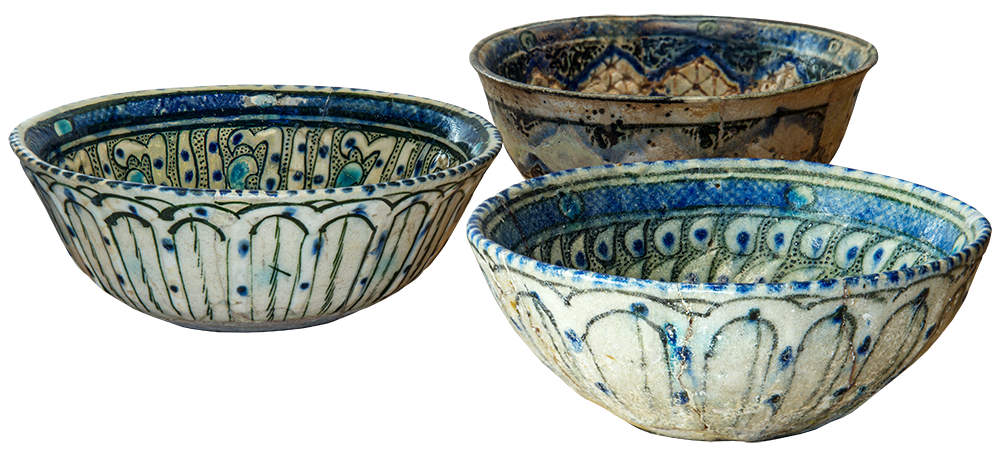Cups

Cities of Golden Horde were vast handicraft centers. Quarters of those cities were inhabited by handicraft specialists in metallurgy, pottery, jewelry, glass production, bone carving, etc. Pottery was the most developed field.
A pottery of 14th century, which was as big as a quarter in the first capital of Golden Horde – Saray al-Makhrus, – was excavated at Akhtuba riverbank. All imaginary types of glazed or non-glazed pottery were burnt in kilns, which sometimes were indeed complicated engineering structures.
Different forms for cup and tile manufacturing, as well as baking tools and rejected items, were found next to such kilns. A variety of cups, dishes, jars and vessels for finger washing were produced of clay and fritware (milled quartz sand mixed with white clay, lime and other components, heated with the temperature 1000°–1200°С) were imitating china. They were also carved or applied a relief, and then covered with clear of colored glazing. Plant and geometric patterns sometimes supplemented with Arabic ligatures were combined in ornaments. Such a technique was usually used for drinking bowls.
Cups from Silitrennoye site are decorated with drop-like details, which are named “peacock eye”. Eventually this ornament is a stylized so-called “diving fish”. Such an ornament originates at the territory of the Far East, and fish there is a symbol of happiness. In the middle of such cups are usually pictured waterfowl birds, lotus flowers or hexagrams.
“Rice grain” technique is also an outstanding one. Artisans dried a vessel a little, than drilled tiny holes, glazed it, colored and baked it. Such a technique originates in China, where such holes were made after rice grains, which burned down during baking and left holes in a vessel. A glazing, however, covered such holes. Sunlight could be seen through the shell of the vessel after firing.
In Golden Horde people often used a specialized pottery – so-called “albarello”. These were tiny vessels with a special cylindrical narrowed neck. Most of these vessels are concentrated at the Lower Volga territory, but are often found elsewhere at the territory of former Golden Horde. You could cover such a vessel with a piece of paper, cloth or skin and tie it, in order to prevent any losses of priceless liquids or dry medicines. Such a form is an evolution of the Near East’ bamboo vessels, which were used in a same way. And after 14th century “albarello” were frequently known in Europe, especially in Italy and France.
The shapes of red and gray ware vary in kitchen, domestic and preservation vessels, for example jars, amphorae, pots, dishes, coverings, pans, lamps, moneyboxes, toys etc. Special sphero-conical vessels for transporting mercury and other liquids of high value should as well attract you.
